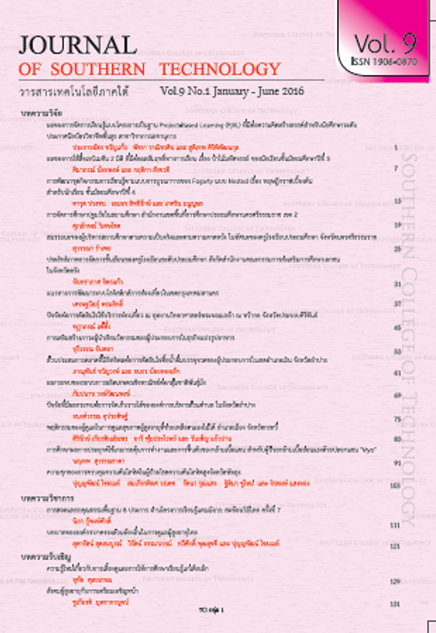การศึกษาผลการประยุกต์ใช้เกมกระตุ้นการทำงานและการฟื้นตัว ของกล้ามเนื้อแขน สำหรับผู้ป่วยกล้ามเนื้ออ่อนแรงด้วยปลอกแขน "Myo"
Main Article Content
Abstract
การวิจัยนี้มีวัตถุประสงค์เพื่อ (1) ศึกษาการพัฒนาเกมกระตุ้นที่ช่วยในการกายภาพบำบัด เพื่อควบคุมการเล่นโดยผ่านปลอกแขน “Myo” (2) ศึกษาประสิทธิภาพของเกมกระตุ้นและฟื้นตัวของกล้ามเนื้อสำหรับผู้ป่วยกล้ามเนื้ออ่อนแรงด้วยปลอกแขน “Myo” และ (3) ศึกษาและหาแนวทางการทำกายภาพบำบัด โดยการเล่นเกมผ่านปลอกแขน “Myo” ได้พัฒนาเกมที่ควบคุมการเล่นผ่านอุปกรณ์ปลอกแขน “Myo” ลักษณะการเล่นใช้ท่าทางในการควบคุมทิศทาง ซึ่งส่งผลให้ผู้ป่วยได้ฝึกการเคลื่อนไหวแขน ช่วยให้การฟื้นฟูแขนของผู้ป่วยดีขึ้น ออกแบบเกมให้มีความยาก 3 ระดับ จำแนกตามท่าทางในการทำกายภาพบำบัด จากระดับที่มีความง่ายสุดจนถึงระดับที่มีความยาก ประชากรที่ใช้ประกอบด้วย (1) ผู้เชี่ยวชาญด้านการแพทย์ จำนวน 3 คน (2) ผู้เชี่ยวชาญด้านเทคนิค จำนวน 4 คน และ (3) นักกายภาพบำบัด จำนวน 3 คน เครื่องมือวิจัย ประกอบด้วย (1) เกมกระตุ้นการทำงานและการฟื้นตัวของกล้ามเนื้อแขนสำหรับผู้ป่วยกล้ามเนื้ออ่อนแรงด้วยปลอกแขน “Myo” ผู้วิจัยได้พัฒนาให้มีคุณสมบัติ คือ ด้านเทคนิคพัฒนาเกมโดยใช้โปรแกรม Unity 4.6.2 และ 2) แบบประเมินด้านการแพทย์ ซึ่งการพัฒนาเกมกระตุ้นการทำงานและฟื้นตัวของกล้ามเนื้อแขนสำหรับผู้ป่วยกล้ามเนื้ออ่อนแรงด้วยปลอกแขน “Myo” ผ่านการประเมินจากผู้เชี่ยวชาญทางด้านการแพทย์ ในระดับดีมาก คิดเป็นค่าเฉลี่ยที่ 4.52 และผู้เชี่ยวชาญทางด้านเทคนิคในระดับดี คิดเป็นค่าเฉลี่ยที่ 3.97
ทั้งนี้ได้นำเกมที่ผ่านการประเมินจากผู้เชี่ยวชาญ ไปทดลองใช้กับนักกายภาพบำบัดแทนการใช้กับผู้ป่วยจริง สามารถสรุปผลความพึงพอใจที่มีต่อเกมภาพรวมในระดับดี คิดเป็นค่าเฉลี่ยได้ 3.61 เมื่อพิจารณาจากผลการประเมินจากผู้เชี่ยวชาญ และกลุ่มตัวอย่างสามารถสรุปได้ว่า เกมกระตุ้นการทำงานและการฟื้นตัวของกล้ามเนื้อแขนสำหรับผู้ป่วยกล้ามเนื้ออ่อนแรงด้วยปลอกแขน “Myo” สามารถนำไปใช้เป็นส่วนหนึ่งของการทำกายภาพบำบัดให้กับผู้ป่วยได้ และสามารถกระตุ้นหรือเพิ่มความแข็งแรงของกล้ามเนื้อได้ อีกทั้งยังสามารถตรวจวัดการฟื้นตัวของกล้ามเนื้อเทียบกับพัฒนาการในการเล่นเกมได้จริง
The Study on Application of the Game Muscles Activation and Recovery for Patients with Muscular Weakness by “Myo”
The objectives of this research were to (1) develop the Muscles Activation Game (controlled through an armband called ‘Myo’) which is designed to assist physical therapy programs for muscular weaknesses; (2) examine the effectiveness of the Muscles Activation Game on the recovery of patients who have muscle weakness of the arm and (3) explore and investigate methods for physical therapy for arm recovery by playing the Muscles Activation Game.
The game that was developed is controlled through a ‘Myo’ controlled armband which uses gestures to control movement. The design of the game encourages patients to practice moving their hands more often which has the potential to lead to arm recovery. The game was designed with three levels of difficulty (easiest, moderate, difficult) according to the gestures used in physical therapy.
The Muscles Activation Game was initially evaluated by specialist medical personnel (3 specialist physicians, 4 technical specialists and 3 physiotherapists) who rated the game as ‘Very Good’ (mean rating 4.52 on a five point scale).
A trial of the Muscles Activation Game was then conducted with a group of physiotherapists (n=3) who rated the effectiveness of the game as ‘Good’ (mean rating of 3.61 on a five point scale). Given the high ratings by the specialist physicians and the trial group of physiotherapists, it can be concluded that the Muscles Activation Game has the potential to be used as part of physical therapy programs for patients with muscle weakness in the arm.
It is anticipated that the game can be used to stimulate and strengthen arm muscles. The recovery of the muscle can be measured when compared with the actual development occurred from real game playing as well as can be used to measure the recovery of the muscle compared to the development of the actual game playing.
Article Details
-
Authors must agree to the journal publication rules and allow the editors to edit the manuscripts for publication.
-
Author’s right belongs to the author but Journal of Southern Technology holds the right of first publication and thus allow readers to use the article for the purpose of education but not commercial.

